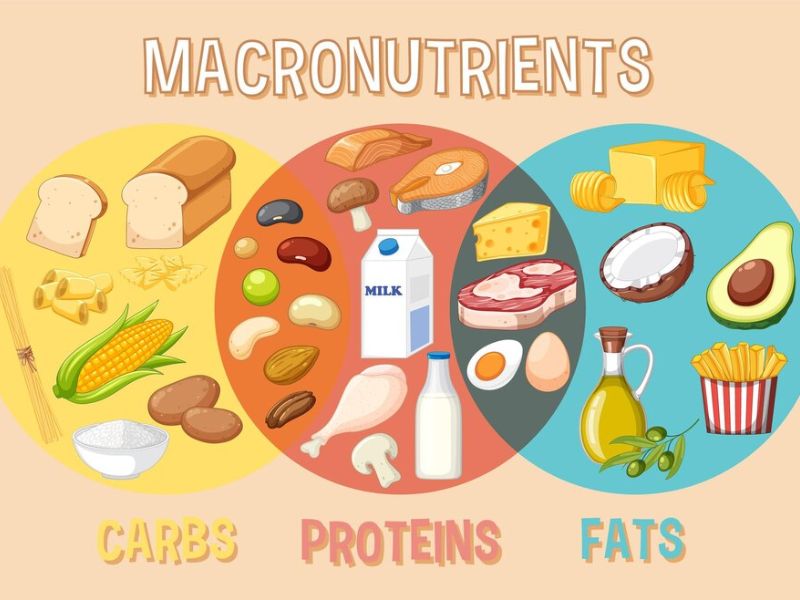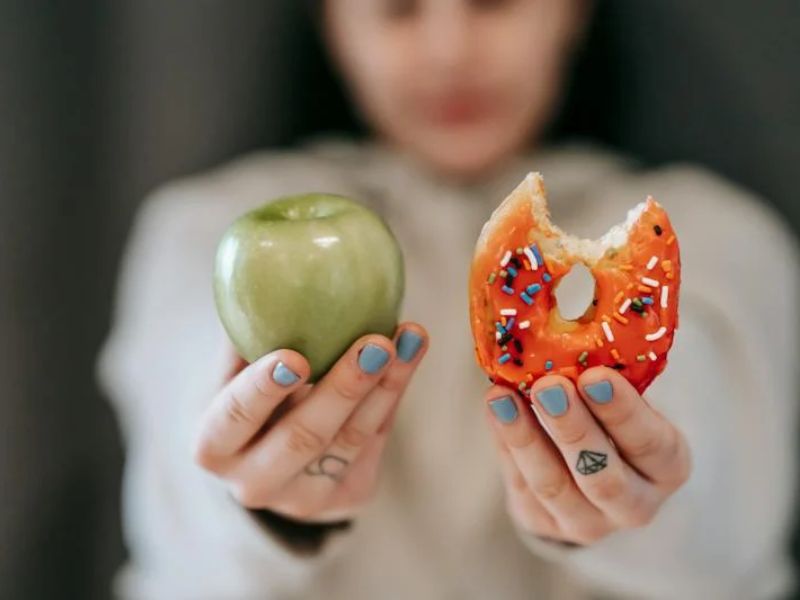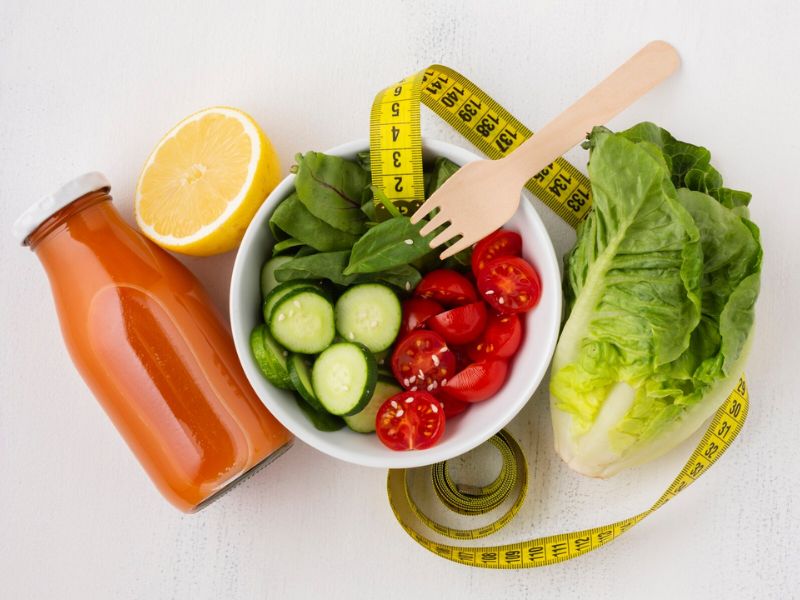Building muscle isn’t just about lifting weights – what you eat plays a bigger role than you might think. Studies show around 70% of muscle growth comes from your diet. This guide simplifies the key ideas behind weightlifting nutrition, helping you make informed choices to fuel your fitness journey.
We’ll break down the essentials: what to eat (protein, carbs, healthy fats.), how much to eat (calories and portion control), and when to eat (pre- and post-workout meals). But it’s not just about following a plan – we’ll show you how to develop healthy eating habits that fit your lifestyle for long-term success.
Get ready to learn how to eat smartly, train strongly, and reach your fitness goals.
Building Blocks for Weightlifting Newbies
Macronutrients:

Ever feel like you’re grinding at the gym, but the results are slow? Believe it or not, what you eat is just as important as the weights you lift. Imagine your body like a building under construction. To get those muscles popping, you need the right building materials – macronutrients.
Protein: The Muscle Builder
Think of protein like tiny bricks that repair and rebuild your muscles after a workout. Protein-rich foods like lean chicken breast can also help boost metabolism due to the thermic effect of food, where the body burns calories during digestion. (Source: Lisa Richards, Nutritionist).
Research shows more protein can seriously boost muscle growth, especially for beginners. Aim for 0.8-1 gram of protein per pound of bodyweight daily [*].
Need some protein power?
- Meat: Chicken breast, fish
- Eggs: Scramble them, fry them, have them any way you like.
- Plant-based: Beans, lentils, tofu (perfect for vegetarians and vegans)
Tip: Protein powders are a quick and easy way to add extra protein to your diet.
Carbs: Your Body’s Fuel
Carbs are like the gasoline that keeps you going during those tough workouts. They provide energy to power you through your sets.
But not all carbs are created equal. Sugary treats and processed foods might give you a quick burst, but they leave you crashing later.
Focus on complex carbs instead. These take longer to digest, keeping you energized throughout your workout. Think:
- Whole grains: Brown rice, quinoa
- Fruits: Bananas, apples
- Vegetables: Broccoli, sweet potatoes
Healthy Fats: Don’t Ditch Them.
Fat often gets a bad rap, but healthy fats are actually good for you. They help regulate hormones, keep you feeling full, and even aid in muscle recovery.
Fill your plate with these healthy fats:
- Nuts and seeds: Almonds, walnuts
- Avocado: Creamy and delicious.
- Fatty fish: Salmon, tuna
For muscle gain, some fitness professionals like Tina Salicco Jackson recommend a protein intake of at least 1 gram per pound of body weight and a macronutrient ratio of 40% protein, 35% fat, and 25% carbs. This split prioritizes protein for muscle building while keeping fat intake moderate and carbs controlled [*].
Micronutrients: The Tiny Powerhouses
Vitamins and minerals, although tiny, are crucial for overall health and keeping your body running smoothly.
Get your micronutrients from:
- Fruits and vegetables: Packed with vitamins and minerals.
- Whole grains: Another source of essential micronutrients.
Calorie Intake and Portion Control

Ever feel lost in a sea of calorie information? You’re not alone. Counting calories can be a confusing hurdle for many weightlifting beginners. But fear not, because understanding your calorie needs is crucial to fueling your fitness journey.
Imagine your body like a furnace. It burns calories throughout the day to function, even at rest. This base burn rate is called your Basal Metabolic Rate (BMR).
Here’s the science: Studies by the National Institutes of Health (NIH) have shown that BMR is influenced by factors like age, sex, height, and weight [8]. A higher BMR means your body burns more calories at rest.
But BMR is just the starting point. Your activity level significantly impacts your overall calorie needs. Weight training burns calories, but not as much as you might think. A 2018 research review published in the journal Sports Medicine found that a single weightlifting session burns around 200-400 calories depending on the intensity and duration [*].
But how many calories exactly?
This is where it gets a bit personal. Several factors influence your calorie needs, including:
- Age: Younger individuals generally have higher BMRs.
- Sex: Men typically have a higher BMR than women due to muscle mass differences.
- Weight: People who weigh more tend to burn more calories at rest.
- Activity level: The more active you are, the higher your calorie needs become. Weight training itself burns calories, but remember, muscle growth requires a surplus.
But how do you track all this? Don’t worry, you don’t need a calculator glued to your hand.
- Online calculators: Many websites offer BMR calculators that factor in your activity level and goals.
- Mobile apps: Several apps can help you track your calorie intake and expenditure.
Portion control: Your best friend

Counting every single calorie can be tedious. Here are some practical tips to manage portion sizes:
- Visual cues: A deck of cards is roughly the size of a recommended protein serving, and your fist is about the size of a healthy carb serving.
- Food labels: Reading labels allows you to understand serving sizes and adjust accordingly.
- Plan your meals: This helps avoid unhealthy choices when hunger strikes.
Pre-workout, Post-workout, and Meal Timing

Imagine this: You crushed your weightlifting session, feeling the pump and ready to conquer your fitness goals. But then, the hunger pangs hit, leaving you wondering – what should I eat to maximize my gains?
Pre-workout:
Think of your body like a car. Before hitting the gym, you wouldn’t drive on an empty tank, would you? The same principle applies to your workouts.
- A pre-workout meal (optional) can provide a quick energy boost, especially for early morning sessions.
- Focus on easily digestible carbs like a banana or a slice of whole-wheat toast.
- Include a protein source like Greek yogurt or a handful of almonds to aid muscle repair.
Post-workout:
This is the golden window for muscle recovery, typically within 30-60 minutes after your workout.
- Research suggests that consuming a meal with a 2:1 ratio of carbs to protein optimizes muscle protein synthesis [*].
- A grilled chicken breast with brown rice or salmon with sweet potato are excellent post-workout options.
Meal Timing:
While pre and post-workout meals are crucial, don’t neglect consistent eating throughout the day.
- Spreading meals and snacks every 2-3 hours helps maintain stable blood sugar levels, which can prevent energy crashes and hinder your workouts.
Addressing common concerns:
- Busy schedule: Pack healthy snacks like nuts, fruits, or pre-portioned yogurt to avoid unhealthy choices on-the-go.
- Not a fan of cooking: Explore meal prepping services or find simple, healthy recipes that fit your taste and lifestyle.
By strategically timing your meals and prioritizing nutrient-rich foods, you’ll provide your body with the necessary tools to recover, rebuild, and ultimately reach your weightlifting goals.
Key takeaways:
- Focus on a balanced diet: Include plenty of fruits, vegetables, and whole grains alongside your protein sources.
- Listen to your body: Adjust your meal timing and portion sizes based on your individual needs and activity level.
Sample Meal Plans

So you’ve hit the gym, feeling motivated to build muscle or shed some fat. But what about food? Fear not, weightlifting newbies. Here are some sample meal plans to get you started:
Remember: These are just examples. You'll need to adjust portion sizes and calorie intake based on your individual goals (muscle gain or fat loss) and activity level. Consulting a registered dietitian is recommended for personalized guidance.
Muscle Gain Meal Plan (Vegetarian):
- Breakfast (around 400 calories): Scrambled eggs (2 whole eggs, 2 egg whites) with chopped spinach and tomato, served with a whole wheat roti (medium size) and a glass of full-fat milk.
- Mid-morning Snack (around 200 calories): Cottage cheese (1 cup) with chopped fruits (berries, mango) and a handful of mixed nuts.
- Lunch (around 500 calories): Dal Makhani (1 cup) with brown rice (1 cup), roasted vegetables (broccoli, cauliflower – 1 cup), and a side salad with a light yogurt dressing.
- Pre-workout Snack (optional, around 200 calories): Banana with peanut butter (2 tbsp).
- Post-workout Meal (around 400-500 calories): Paneer Bhurji (made with crumbled paneer, peppers, onions, tomatoes) with brown rice (1 cup) and a glass of buttermilk.
- Dinner (around 500 calories): Moong Dal Cheela (2 medium cheelas) with mixed vegetable curry (1 cup) and a side of raita.
Fat Loss Meal Plan (Non-vegetarian):
- Breakfast (around 350 calories): Greek yogurt (1 cup) with mixed berries and a sprinkle of chia seeds, served with 2 slices of whole-wheat toast.
- Mid-morning Snack (around 150 calories): Apple slices with a dollop of almond butter.
- Lunch (around 400 calories): Grilled chicken breast (150gm) with roasted vegetables (1 cup) and a small portion of brown rice (½ cup).
- Pre-workout Snack (optional, around 150 calories): Pear with a handful of almonds.
- Post-workout Meal (around 350-400 calories): Fish curry (baked fish – 150gm) with spinach (1 cup) and a small portion of brown rice (½ cup).
- Dinner (around 400 calories): Chicken stir-fry with mixed vegetables (broccoli, carrots, peppers) and a small portion of brown rice (½ cup).
Vegetarian/Vegan Options:
- Replace paneer with tofu in the Muscle Gain plan.
- Opt for lentil-based dishes like rajma or chole for protein in both plans.
- Include plant-based protein sources like dals, legumes, tofu, and soy products.
Here's a sample meal plan inspired by fitness expert Marc Massad. It incorporates protein sources like chicken breast or tofu, whole grains such as quinoa, healthy fats from avocado or olive oil, and vegetables. Remember, portion control is crucial. This is just a starting point, and consulting a professional for personalized guidance is always recommended.
Building Sustainable Healthy Eating Habits

Let’s face it, restrictive diets are often a recipe for frustration. The key to success, especially for weightlifting newbies, is cultivating sustainable healthy eating habits.
Imagine this: You meticulously follow a complex meal plan for a while, but the restrictions become overwhelming. Eventually, you ditch the plan and fall back into old habits. Sound familiar?
Here’s the thing: Building a healthy relationship with food is crucial for long-term success.
Focus on:
- Variety: Include a rainbow of fruits and vegetables, whole grains, lean protein sources, and healthy fats in your diet. This ensures you get all the essential nutrients your body needs to function optimally and recover from your workouts.
- Think whole foods: Swap processed snacks for whole grains, lean proteins, and healthy fats. Studies like a 2019 research review published in the journal Nutrients highlight the link between a whole-food diet and improved overall health.
- Don’t Ditch the Carbs: Complex carbs like whole grains, sweet potatoes, and brown rice provide sustained energy to crush your workouts.
- Mindful munching: Pay attention to your hunger cues. Eat slowly, savor your food, and avoid distractions like screens while eating. This mindful approach can help you avoid overeating and make informed food choices.
Let’s address some common challenges:
- Cravings: We all have them. Instead of reaching for sugary treats, opt for healthier alternatives like fruits with nut butter or yogurt with berries.
- Eating out: Research restaurant menus beforehand and choose options that align with your goals. Many restaurants offer healthy options if you know what to look for.
- Social gatherings: Don’t deprive yourself entirely. Enjoy occasional treats in moderation, but focus on making healthy choices most of the time.
- Combining a balanced diet with consistent weight training is a powerful formula for success. You’ll not only build muscle and improve your physique but also cultivate a healthy lifestyle that you can maintain for the long term.
Remember, building muscle requires a balance between diet and exercise. Registered Dietitian Dan Gallagher emphasizes prioritizing protein intake while getting your nutrients from whole foods and incorporating regular exercise, including both cardio and weight training. He also recommends avoiding processed foods and excessive sugar to achieve optimal results.
Conclusion
Congratulations on completing this guide to weightlifting nutrition. You now understand the crucial role of diet in achieving your fitness goals, from fueling workouts to supporting muscle growth and recovery.
Remember, it’s not just about lifting weights—it’s about nourishing your body with the right nutrients. By implementing the strategies outlined here, like focusing on macronutrients, managing portion sizes, and timing your meals effectively, you’re setting yourself up for success.
Stay consistent, be patient, and celebrate your progress along the way. With dedication and smart nutrition, you’re well-equipped to crush your fitness goals and unleash your full potential.
Keep lifting, keep fueling, and keep reaching new heights on your journey to a stronger, healthier you.


2 thoughts on “Diet for Weightlifting Newbies: Lean Muscle & Strength Gains ”